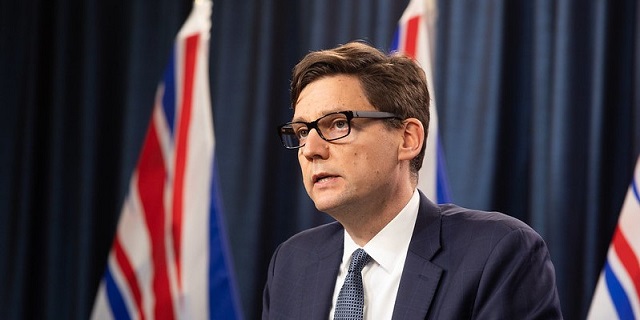Health
B.C. government sends patients to U.S. while fighting private options in B.C.

From the Fraser Institute
By Mackenzie Moir and Bacchus Barua
Among universal health-care countries, after adjusting for age, Canada ranked highest for health-care spending as a percentage of the economy in 2021 (the latest year of available comparable data). The problem is how we do universal health care
The recent ordeal of Allison Ducluzeau, a wife and mother from Victoria who spent more than $200,000 out of pocket to seek life-saving cancer treatment in the United States, has been widely shared on social media. Unfortunately, Ducluzeau’s story is not unique.
According to Second Street, a Canadian research organization, Canadians made approximately 217,500 trips abroad to seek health care in 2017, long before the pandemic (and related health-care backlogs and delays). To understand why this happens within our universal system, simply look at the data. In 2023, Canadians could expect a median wait of 27.7 weeks between referral to treatment across 12 medically-necessary specialities. In B.C., patients had to wait four weeks to see an oncologist, and another 5.9 weeks for treatment. In fact, the total wait between referral to treatment for oncology in B.C. (9.9 weeks) is now about twice as long as the Canadian average (4.8 weeks).
Moreover, the Canadian Institute for Health Information reported last year that, among provinces, B.C. was the second-worst performer in the country in meeting the national benchmark for radiation therapy (that is, receiving treatment within four weeks after seeing a specialist).
Why is this happening? Why do B.C. patients face such daunting wait times for potentially life-saving treatment?
For starters, compared to its universal health-care peers, Canada has fewer medical resources available. After adjusting for population age differences among high-income universal health-care countries, Canada ranked 28th (out of 30 countries) for the availability of doctors, 23rd (of 29) for hospital beds, 26th (of 30) for CT scanners and 19th (of 26) for PET scanner availability.
In response to B.C.’s long delays for cancer care, the Eby government recently instituted a cross-border initiative that sends patients to Washington State for treatment. Although this is good news for some patients, it’s not a long-term solution to our health-care woes. And this selective and short-term initiative is cold comfort to patients suffering from other medical conditions and who remain without local options as they endure long delays for medically-necessary care. Indeed, Allison Ducluzeau needed chemotherapy and could not take advantage of this initiative.
To be clear, Canada’s relative dearth of resources and long wait times are not due to inadequate funding. Among universal health-care countries, after adjusting for age, Canada ranked highest for health-care spending as a percentage of the economy in 2021 (the latest year of available comparable data). The problem is how we do universal health care. Unlike Canada, most other universal health-care countries fund their hospitals according to activity levels to incentivize treatment. And they understand that the private sector is a valuable partner in their universal health-care frameworks.
For defenders of the status quo, private involvement in the financing and delivery of health care within our borders remains out of the question. In fact, the same Eby government that sends B.C. patients across the border for care has fought against private options in B.C. And you can be sure that PeaceHealth St. Joseph Cancer Center and the North Cascade Cancer Center in Washington State—where the Eby government is sending cancer patients—will not be subject to the same limitations the Eby government imposes on private clinics in B.C.
If the provincial government is unable to deliver timely access to care through our publicly-funded health-care system, it should allow patients to pay privately for alternatives within our borders. By forcing patients such as Allison Ducluzeau to leave their loved ones and travel abroad to receive life-saving treatment, our policymakers yet again cling to a stubborn and failed approach to universal health care.
Authors:
Health
Saskatchewan woman approved for euthanasia urged to seek medical help in Canada rather than US

From LifeSiteNews
Saskatchewan Premier Scott Moe encouraged Jolene Van Alstine, who has a rare disease, to work with his government on a solution.
Saskatchewan Premier Scott Moe is urging a woman with a rare disease, who has been approved to die by euthanasia because she can’t get proper care, to instead work with his government on a solution.
As reported by LifeSiteNews last week, Saskatchewan resident Jolene Van Alstine was approved to die by state-sanctioned euthanasia because she has had to endure long wait times for what she considers to be proper care for a rare parathyroid disease.
Van Alstine’s condition, normocalcemic primary hyperparathyroidism (nPHPT), causes her to experience vomiting, nausea, and bone pain.
As a result of Van Alstine’s frustrations with the healthcare system, she applied for Canada’s Medical Assistance in Dying (MAiD) and was approved for a January 7, 2026, death date.
Her case drew the attention of American media personality Glenn Beck, who has been in contact with Van Alstine to determine whether she can get the surgery done in the United States. Even the administration of U.S. President Donald Trump has been briefed on the matter.
According to Moe, Van Alstine has taken her case to Saskatchewan Health Minister Jeremy Cockrill, asking for help.
“There has been an opportunity to see specialists in Saskatchewan and outside of Saskatchewan, and those conversations about maybe potentially seeing additional specialists continue with the minister’s office and the Ministry of Health,” Moe said yesterday at a press conference.
“I would hope that she’d continue to work with the Ministry of Health, because I think there’s work going on to see even additional specialists at this point,”
A recent Euthanasia Prevention Coalition report revealed that Canada has euthanized 90,000 people since 2016, the year it was legalized.
Even some lobby groups have pushed for MAiD to be expanded to minors.
As reported by LifeSiteNews, over 23,000 Canadians have died while on wait lists for medical care as Prime Minister Mark Carney’s Liberal government focuses on euthanasia expansions.
Health
Canadian gov’t considers sharing census data on gender-confused children

From LifeSiteNews
Statistics Canada recently consulted LGBTQ+ groups on releasing 2021 census data about gender-confused children ages 0-14, citing research that toddlers could be ‘transgender.’
Statistics Canada is seeking to collect and share data on gender-confused children in its latest move to promote the LGBT agenda to minors.
From November to mid-December, Statistics Canada held consultations with various LGBT groups to discuss how to release 2021 census data on gender-confused children ages 0-14, according to a report shared with the National Post.
“For the upcoming 2026 Census, Statistics Canada has been consulting with the Canadian population, experts and stakeholders on gender,” the government agency wrote in a recent report.
“The Agency has finished conducting extensive qualitative and quantitative testing, notably to assess the impact of modifying the gender response categories to include ‘man’ and ‘woman,’ and ‘boy’ and ‘girl’ for those younger than 15 years,” it continued.
In 2021, StatsCan conducted the first-ever census to collect data on sex assigned at birth as well as how Canadians later ‘identified’ as their gender. The census collected data from Canadians of all ages but only published that of Canadians 15 years and older.
According to the information, released April 2022, 0.33% of the Canadian population age 15 or older were gender-confused, with 0.19% believing they are transgender and 0.14% believing they are non-binary.
The report noted that “younger generations may be more comfortable reporting their gender identity than older generations.”
Now, StatsCan is seeking to further push the LGBT agenda on young children by releasing data to support their argument that young children can be “transgender.”
According to a copy of its most recent report, “children and youth are often assumed to be cisgender (people whose reported gender corresponds to their birth sex) from birth until they ‘come out’ as a different gender on their own accord.”
“Researchers suggest that children aged 18 to 24 months are developmentally capable of recognizing gender norms and expressing gendered behaviours in visible ways,” it continued.
“Research also suggests that, like cisgender children, transgender and non-binary children may recognize their own gender identity as early as 2 to 3 years old or during later childhood or early adolescents,” the document read.
The StatsCan report conveniently ignores scientific data on the harms of gender-transitioning interventions, both on the physical and mental health of individuals, particularly children.
A significant body of evidence shows that “affirming” gender confusion carries serious harms, especially when done with impressionable children who lack the mental development, emotional maturity, and life experience to consider the long-term ramifications of the decisions being pushed on them, or full knowledge about the long-term effects of life-altering, physically transformative, and often irreversible surgical and chemical procedures.
Studies find that more than 80 percent of children suffering gender dysphoria outgrow it on their own by late adolescence and that “transition” procedures, including “reassignment” surgery, fail to resolve gender-confused individuals’ heightened tendency to engage in self-harm and suicide – and even exacerbate it, including by reinforcing their confusion and neglecting the actual root causes of their mental strife.
As LifeSiteNews has previously noted, research does not support the assertions from transgender activists that surgical or pharmaceutical intervention to “affirm” confusion is “necessary medical care” or that it is helpful in preventing the suicides of gender-confused individuals.
In fact, in addition to asserting a false reality that one’s sex can be changed, transgender surgeries and drugs have been linked to permanent physical and psychological damage, including cardiovascular diseases, loss of bone density, cancer, strokes and blood clots, infertility, and suicidality.
There is also overwhelming evidence that those who undergo “gender transitioning” are more likely to commit suicide than those who are not given irreversible surgery. A Swedish study found that those who underwent “gender reassignment” surgery ended up with a 19.2 times greater risk of suicide.
Indeed, there is proof that the most loving and helpful approach to people who think they are a different sex is not to validate them in their confusion but to show them the truth.
A new study on the side effects of transgender “sex change” surgeries discovered that 81 percent of those who had undergone “sex change” surgeries in the past five years reported experiencing pain simply from normal movement in the weeks and months that followed — and that many other side effects manifest as well.
-

 Digital ID2 days ago
Digital ID2 days agoCanada releases new digital ID app for personal documents despite privacy concerns
-

 Community2 days ago
Community2 days agoCharitable giving on the decline in Canada
-

 Bruce Dowbiggin2 days ago
Bruce Dowbiggin2 days agoNFL Ice Bowls Turn Down The Thermostat on Climate Change Hysteria
-

 Crime2 days ago
Crime2 days agoTrump designates fentanyl a ‘weapon of mass destruction’
-

 Energy2 days ago
Energy2 days agoCanada’s sudden rediscovery of energy ambition has been greeted with a familiar charge: hypocrisy
-

 Energy2 days ago
Energy2 days agoCan we not be hysterical about AI and energy usage?
-

 Energy2 days ago
Energy2 days agoEnergy security matters more than political rhetoric
-

 Alberta1 day ago
Alberta1 day agoCanada’s New Green Deal








